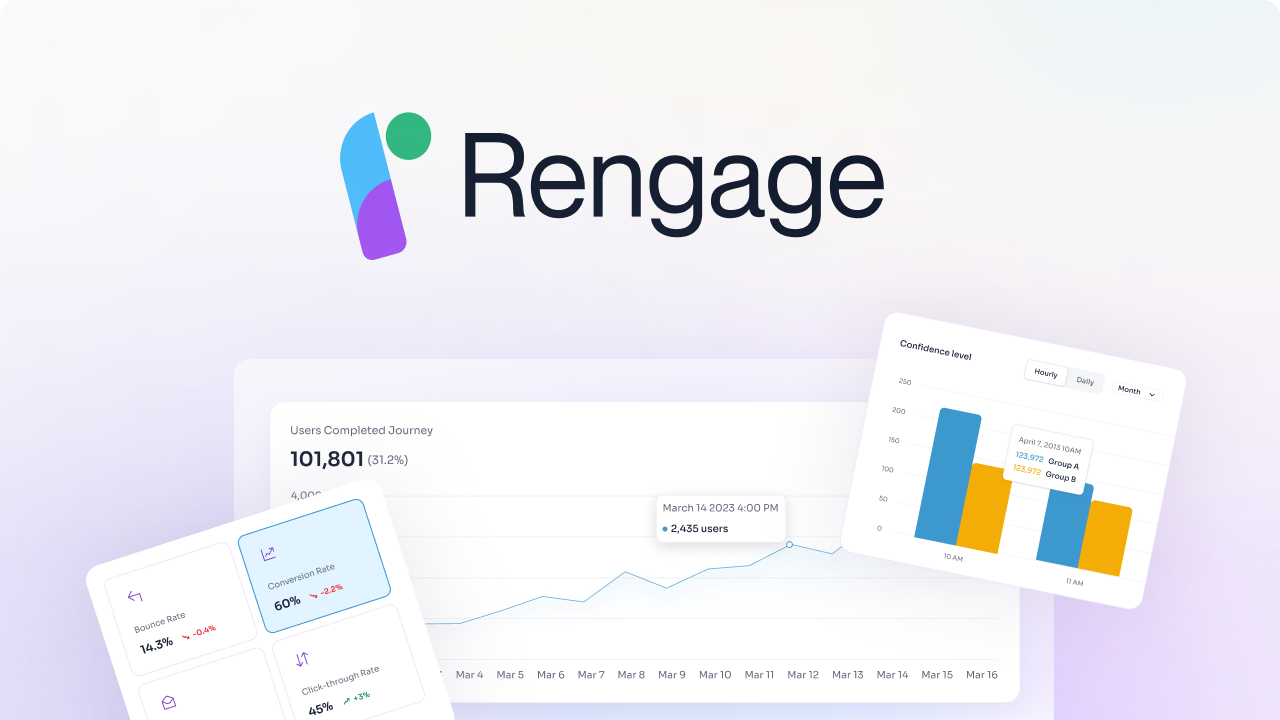Picture this: you have a diverse customer base, each with varying preferences and buying habits. Now, imagine being able to unravel these intricate patterns to tailor your marketing strategies, transforming customer interactions into personalized experiences that drive loyalty and growth. This is where customer segmentation analysis comes in, offering the insights you need to effectively understand, identify, and group your customers. If you're striving to elevate your customer relationships to new heights, this article is your gateway to unlocking the power of predictive behavior analytics.
What is Customer Behavior?

Consumer behavior means understanding the process and means by which audiences make final decisions. It includes focusing on their actions, engagement patterns, and usage or disposal of specific products or services—and the mental, emotional, and behavioral responses that trigger those actions.
Importance of Studying Customer Behavior for Marketers
Why do marketers need to study it? Simply because the influence of psychology is a key factor in forming preferences, which eventually leads to purchases. The ability to connect with your audience right from the beginning of their journey, to instill trust and convey why and how you reign supreme over your competitors can win you life-long customers, a.k.a. recurring business opportunities.
The Fundamental Insights Provided by Consumer Behavior Research
Every business has an ICP and buyer personas they want to target. Consumer behavior marketing provides the fundamentals for understanding who you’re targeting and what potentially would interest them. Consumer behavior research provides the underlying element that drives quality strategies and ensures business results.
Apple: A Case Study in Predicting Customer Behavior
Think about Apple. Behind its winning marketing strategies and an ever-increasing number of customers who swear by its products is its ability to change with the shifts in consumer behavior. With iTunes capturing first-party data, or the company leveraging reference groups, or hooking people on product experiences, Apple invests greatly in understanding its customers.
Leveraging Consumer Insights to Drive Business Growth
After understanding how important is behavior analysis, the next obvious question would be: How to make your customers say yes to your products or services?
5 Factors That Influence Customer Behavior

1. Psychological Factors Influencing Customer Behavior
Motivation, perception, learning, attitudes, and beliefs play a significant role in shaping consumer behavior. Motivation drives consumer choices, while perception and learning influence how customers interpret information and make decisions. Attitudes and beliefs affect how consumers view products and services, shaping their buying behavior.
2. Social Factors Influencing Customer Behavior
Social factors such as family, reference groups, and roles and status impact consumer behavior. Family influences consumer preferences, while reference groups and social status influence purchasing decisions based on group associations and societal roles.
3. Cultural Factors Influencing Customer Behavior
Culture, subculture, and social class strongly influence consumer behavior. Cultural values and behaviors learned from family and society shape buying decisions. Subcultures create diverse consumer segments, and social class impacts purchasing trends based on income, occupation, education, and location.
4. Personal Factors Influencing Customer Behavior
Age, income, occupation, and lifestyle are personal factors that influence consumer behavior. Individuals make buying decisions based on their life stage, earning potential, professional role, and personal preferences, contributing to varied consumer perceptions and behaviors.
5. Economic Factors Influencing Customer Behavior
Economic factors like personal income, family income, consumer credit, liquid assets, and savings influence consumer purchasing habits. Disposable income, family earnings, credit availability, liquid assets, and saving preferences impact consumer spending, particularly on essential and luxury items.
Have you ever wanted to drive loyalty and growth by predicting customer behavior? Rengage offers a comprehensive solution for managing and enhancing customer journeys. Book a free demo to learn more about transforming customer interactions into personalized experiences that drive loyalty and growth.
Related Reading
- Customer Data Infrastructure
- Omnichannel Analytics
- Customer Data Integration
- Marketing Data Platform
- Customer Data Platform Vs Data Management Platform
- Customer Data Platform Use Cases
- Best Customer Data Platform
- Customer Data Platform Capabilities
- Customer Data Platform Tools
- How To Choose Cdp
4 Major Types of Customer Behavior

1. Complex Purchasing Behavior
Complex purchasing behavior is when customers research extensively before making a significant purchase. This behavior is common when buying expensive or rarely purchased items, like a house or a car. Businesses must understand this behavior as it requires a strategic marketing approach that provides detailed information to help customers make informed decisions.
2. Dissonance-Reducing Purchasing Behavior
Dissonance-reducing purchasing behavior happens when customers are indecisive and struggle to differentiate between brands. In this case, customers do not have a favorite brand and fear they might regret their decision. This behavior is evident when buying products with similar features but different brand names. Businesses should address this behavior by providing clear differentiators and value propositions to alleviate customer doubts.
3. Habitual Purchasing Behavior
Habitual purchasing occurs when customers make routine purchases with little to no involvement in the product or brand category. For example, when someone buys bread from the same brand on every grocery trip, they exhibit habitual behavior. Understanding this behavior helps businesses build brand loyalty and maintain a consistent customer base through targeted marketing strategies.
4. Variety-Seeking Behavior
Variety-seeking behavior refers to customers who seek novelty and variety in their purchases. These customers switch products not because they are dissatisfied with the current one but because they desire a change. For instance, people who alternate between different flavors of protein supplements exhibit variety-seeking behavior. Businesses should cater to these customers by offering a diverse product range and engaging marketing campaigns to maintain their interest.
Detailed 4-Step Guide for Predicting Customer Behavior

1. Identifying Prospects
To begin predicting customer behavior, it is essential to start by identifying prospects. This involves categorizing customers into specific segments based on various data points such as demographics, geographic, product channels, and previous purchases. By creating profiles of customers and clustering them with others who share similar traits, companies can tailor interactions for relevance. Leveraging advanced tools like Verfacto can capture technical attributes like AOV, RFM, attention rate, sessions, and returners for precise targeting.
2. Feature Extraction to Create Profiles
Feature extraction is crucial to creating customer profiles. This step involves asking critical questions such as who your best customers are, why they choose your brand, what they buy, and why they select your products over competitors. Companies can better understand customer behavior and cater to their specific needs by identifying different engagement patterns.
3. Creating Models to Analyze Customer Behavior
Once customer segments are established, machine learning can predict future actions such as high or low purchase intent, churn rates, preferred products, and more. Assigning a numerical value to each metric allows for a better assessment of each customer's standing regarding qualified or unqualified leads. Tools like Verfacto offer data visualizations that compare critical metrics like customer recency, frequency, and monetary value of purchase.
4. Customizing Communication to Create a Better Pipeline
By creating real-time customer profiles, companies can effectively personalize communication to specific segments. This involves triggering targeted campaigns based on customer intent levels. For top-of-the-funnel leads, informative and value-driven content like blogs, videos, and infographics helps build trust. Middle or bottom-funnel leads benefit from brand-driven content such as case studies and testimonials to showcase the brand's superiority over competitors. Personalization in marketing and sales enhances customer engagement and improves conversion rates across different sales funnel stages.
Related Reading
- Customer Retention Automation
- Customer Data Integration Best Practices
- Real Time Customer Segmentation
- Chat CDP
- Customer Data Platform Implementation
- Benefits Of A Customer Data Platform
- Customer Segmentation Solutions
- Omnichannel Measurement
- AI Customer Segmentation
- AI CDP
- Customer Data Platform GDPR
- Customer Data Platform Costs
- CDP Personalization
Top 11 Tools for Predicting Customer Behavior
1. Rengage: Accelerate Customer Journeys with Intuitive Features

As a comprehensive solution for managing and enhancing customer journeys, Rengage delivers insights with no code required, influencing measurable outcomes. Rengage excels in transforming customer interactions into personalized experiences that encourage loyalty and growth. Standout features include Journey Moments for insights into micro-segments, Journey Builder for intuitive multi-channel marketing automation, and Insights prediction and attribution.
2. HubSpot: Enhance Customer Experience with Behavioral Targeting
HubSpot is a CRM tool that allows brands to personalize marketing outreach through behavioral targeting. It enables tracking of customer personas and engagement activities such as web visits, email interactions, and form submissions. Currently used by over 113,000 companies globally, HubSpot helps identify high-intent behaviors, nurturing customers towards purchasing points.
3. Optimizely: Optimize Customer Journeys with Experience Analytics
Optimizely transcends tracking basic data on churn and conversions, offering experience analytics to understand and optimize customer journeys. The tool creates strategies based on customer behavior, preferences, and history, enabling brands to make data-driven decisions at every touchpoint.
4. Google Analytics: Analyze User Behavior Across Channels
Google Analytics remains a stalwart in the analytics realm, capturing detailed interactions through event tracking. Ecommerce brands can leverage Enhanced Ecommerce tracking to comprehend user behavior across online experiences. Easy to use and versatile, Google Analytics helps brands gauge website performance, channel engagements, and more with comprehensive reporting options.
5. Verfacto: Transform Raw Data into Actionable Insights
Verfacto is a modern e-commerce analytics tool that solves contemporary marketing challenges. It excels in capturing customer behavioral attributes, hyper-targeting, building enriching customer experiences, and boosting campaign performance through contextual communication. Among its key features are real-time actionable insights, behavioral analytics, advanced segmentation, and precise reporting.
6. Woopra: Optimize Marketing Campaigns with Real-Time Insights
Woopra is an end-to-end customer journey and product analytics tool offering real-time insights into customer actions. The platform visualizes browsing patterns and offers cohort reports for analyzing and comparing growth trends. By using user behavior data, marketers can optimize campaigns, enhance customer experience, and spot process gaps.
7. CleverTap: Drive Customer Engagement with Personalized Messaging
CleverTap is a machine learning-powered platform delivering personalized messaging and predictive analytics to drive customer engagement and retention. Through user segmentation, brands can identify high-value customer segments for targeted campaigns. Cohort analysis and predictive analytics capabilities help brands proactively predict future behaviors and address customer needs.
8. Mixpanel: Track Customer Engagement Across Digital Products
Mixpanel provides detailed customer behavior analytics for tracking engagement across digital platforms. Whether on websites, mobile apps, or other platforms, the tool offers insights into how customers interact with your products, enabling data-driven decision-making for optimizing customer experiences.
9. YouTube Analytics: Analyze Video Content Performance
YouTube Analytics is a valuable tool for creators, offering insights into demographic data, visitor duration, video-sharing metrics, and audience engagement. Content creators can spot trends, identify at-risk customers, and optimize content visibility using features like watch time reports, sharing metrics, and audience engagement reports.
10. Amplitude: Track Analytics Across Digital Platforms
Amplitude is a self-service customer analytics platform for small businesses to track analytics across digital platforms. The tool enables experimentation with different data to convert customer interactions into actionable insights, empowering data-driven decision-making.
11. Hotjar: Gain Deep Insights into Website Visitor Activities
Hotjar provides detailed customer behavior analytics through heat maps and reports, offering profound insights into website visitor activities. By leveraging Hotjar, small-business owners can identify areas for website improvement, enhance user experience, and drive conversations through continuous insights.
What Are the Benefits of Predicting Customer Behavior?

Enhance customer understanding
Understanding customer behavior is a key aspect of any successful business strategy. By analyzing data collected from various touch points across the user journey, companies can gain comprehensive insights into customer demographics, preferences, interests, brand affinity, emotional drivers, and more. This deep understanding allows businesses to tailor their marketing strategies, product offerings, and customer experiences to effectively meet and exceed customer expectations, ultimately driving customer satisfaction and loyalty.
Personalize marketing and product recommendations
Personalization has become a cornerstone of successful marketing efforts today, and predicting customer behavior plays a crucial role in enabling personalized experiences. By segmenting customers based on their preferences, interests, and buying behaviors, and predicting their future desires, businesses can create targeted campaigns that resonate with customers in the moment. This level of personalization allows businesses to target customers with relevant product and service recommendations, enhancing the overall customer experience and driving increased sales and revenue.
Improve customer retention and loyalty
Businesses can gain insights into customer satisfaction levels, loyalty, and churn patterns by analyzing customer behavior over time. This information allows companies to identify customers at risk of churning and intervene with proactive measures to prevent customer loss. Understanding consumer preferences and behaviors enables businesses to provide tailored experiences, personalized offers, and exceptional service, fostering customer loyalty, reducing churn rates, boosting retention, and increasing lifetime value.
Optimize pricing and inventory management
Analyzing customer behavior patterns helps businesses optimize pricing and inventory management strategies by monitoring responses to pricing changes and other factors. Businesses can improve profitability and customer satisfaction by identifying optimal price points that appeal to customers and maximizing sales and revenue. Data insights from customer behavior analysis enable businesses to forecast demand, recognize seasonal trends, and optimize inventory levels, avoiding overstocking or stockouts. Thus, businesses optimize pricing and inventory management in alignment with customer behavior.
Data-driven decision making:
One of the most significant benefits of predicting customer behavior is the ability to drive data-driven decision-making. By harnessing the power of analytics, businesses can make informed decisions based on empirical evidence rather than intuition or guesswork. This data-driven approach enables businesses to align their strategies with actual customer behavior, ultimately increasing the chances of success and profitability.
Related Reading
- CDP Marketing Automation
- Customer Data Platform Vs Marketing Automation
- Ecommerce Cdp
- Totango Competitors
- Centralized Marketing Data
- Customer Data Management Best Practices
- Segment Alternatives
- Blueconic Cdp
- Emarsys Competitors
- Actioniq Competitors
What Are the Challenges of Predicting Customer Behavior?

Data Privacy Concerns and Predicting Customer Behavior
Businesses have to tackle data privacy concerns head-on when predicting customer behavior. Securing data and ensuring privacy are essential for maintaining trust, compliance, and ethics in data handling. Transparent data collection practices can foster customer trust and help address privacy concerns effectively.
Inaccurate Data and Analysis: The Pitfall to Avoid
Inaccurate data and flawed analysis are key challenges in predicting customer behavior. Incomplete, outdated, or inaccurate data can lead to unreliable predictions. Misinterpreting results, using the wrong statistical methods, or lacking proper context for data can also undermine the accuracy of predictions. Ensuring data quality, employing the right analysis techniques, and validating data can help improve the reliability of behavioral predictions.
Adapting to Changing Customer Behavior
Customer behavior is ever-changing, making it critical for businesses to adapt swiftly. Monitoring market trends, engaging with customers directly, and analyzing data can help identify shifting patterns in customer behavior. By staying agile and responsive to changing customer preferences, businesses can maintain a competitive edge amidst evolving customer behavior.
Overcoming Limited Resources and Technology Challenges
Limited resources and outdated technology can impede the accurate prediction of customer behavior. Investing in advanced predictive analytics models and streamlined data collection tools can help businesses overcome these challenges. Upgrading technology and tools can enhance insights, making it easier to predict customer behavior accurately.
Create Personalized Experiences That Drive Loyalty and Growth with Rengage — Book A Free Demo Today
Rengage's advanced platform offers businesses a powerful toolset for harnessing the potential of their customer data. By leveraging the power of data analytics and artificial intelligence, Rengage enables businesses to predict customer behavior accurately. By analyzing customer data and interactions, Rengage can provide valuable insights into customer behavior patterns, preferences, and needs. This predictive analysis empowers businesses to effectively tailor their marketing strategies and campaigns to target specific customer segments.
Journey Moments: Unlocking Micro-Segments Insights
Journey Moments, a feature of Rengage, provides businesses with insights into their micro-segments. By segmenting customers based on their behaviors, preferences, and interactions, businesses can identify unique patterns and trends within these distinct groups. By understanding the nuances of each micro-segment, businesses can create personalized marketing campaigns that resonate with each group's specific needs and preferences. This personalized approach enhances customer engagement and increases the likelihood of conversion.
Journey Builder: Streamlining Multi-Channel Marketing Automation
Rengage's Journey Builder feature offers businesses an intuitive tool to streamline multi-channel marketing automation. By designing targeted customer journeys that guide customers through personalized touchpoints, businesses can create a seamless and engaging customer experience. The Journey Builder empowers businesses to automate marketing campaigns across various channels, ensuring consistent messaging and brand experience. This streamlined approach enhances customer engagement and drives conversions by delivering the right message to the right audience at the right time.
Insights Prediction and Attribution: Measuring the Impact of Customer Journeys
Rengage's platform provides businesses with valuable insights to measure the impact of their customer journeys accurately. By tracking customer interactions and behaviors throughout the journey, businesses can analyze the effectiveness of their marketing campaigns and strategies. This insights prediction and attribution feature enables businesses to identify which touchpoints and messages drive conversions and customer retention. By attributing success to specific marketing efforts, businesses can optimize their strategies for better results and increased ROI.
